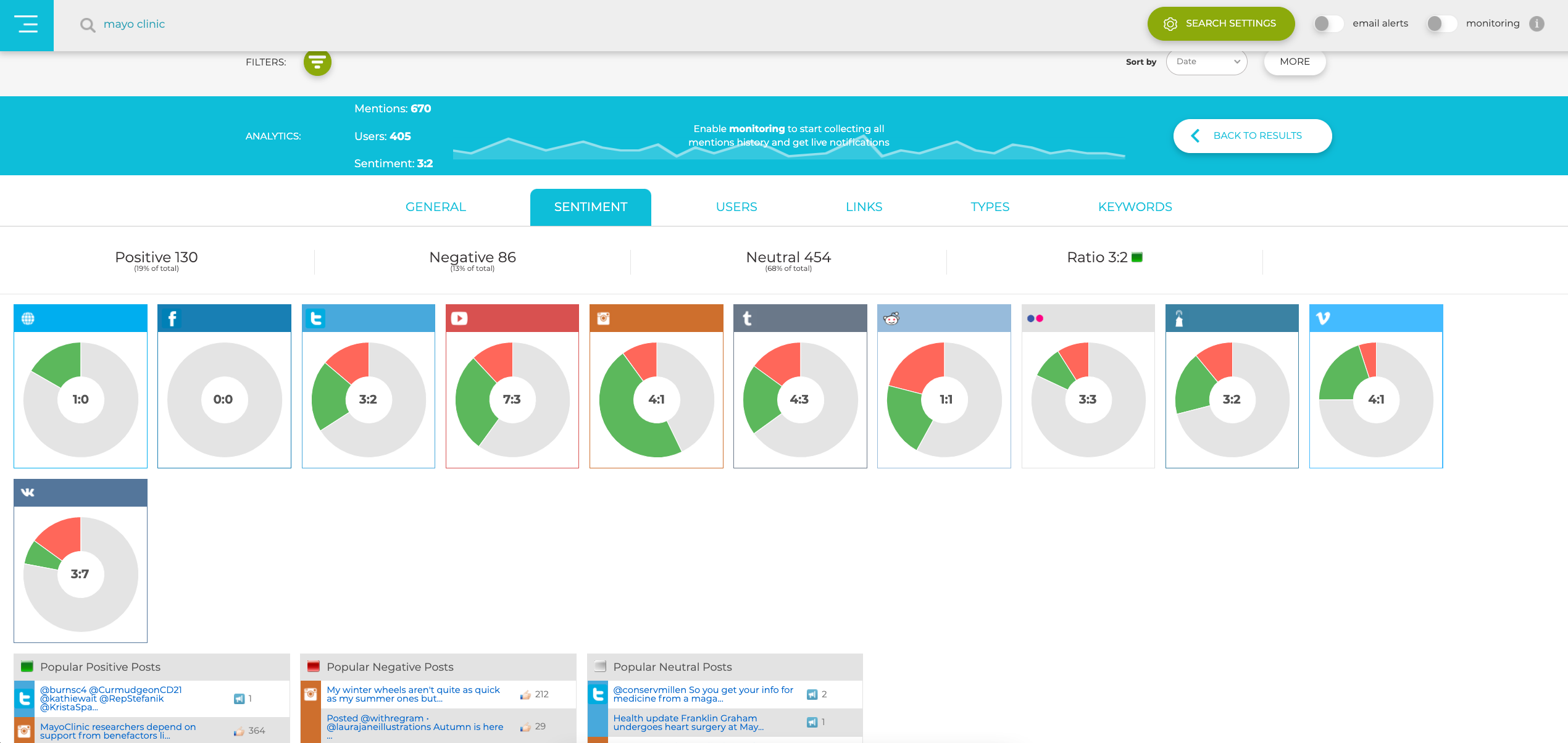It takes many good deeds to build a good reputation and only one bad one to lose it.
Have you ever tried to google your medical practice? Were you satisfied with what you found? Of the 75 percent of US adults who Google themselves, nearly half say the results aren’t positive. Your online reputation can be your strongest asset or your biggest liability. Your flawless business can fail if your online reputation is ruined.
If you don’t like the way you look online, there’s plenty you can do about it. In this article, we share eight tips on how to manage and improve your online reputation. Dive in!
What is online reputation management (ORM)?
Online reputation management (ORM) is the practice of cultivating a positive perception of a brand, business, or person on the internet. With ORM, a person or a brand can mitigate the effects of negative feedback and can prevent or solve problems that could cause reputational damage.
Why is online reputation management important for your medical practice?
Physician online reputation management is especially relevant for medical practices due to high competition and the continuous struggle for patient loyalty and trust. Most patients start their search online and rely on reviews when choosing a healthcare provider. In fact, 90% of US patients use online reviews to evaluate physicians according to a Software Advice survey. Recommendations of close friends and relatives have been replaced by client testimonials.
A clinic’s client visit rate might drop by a third if a physician gets negative media coverage or online reviews.
Often, a physician’s reputation is severely harmed by:
- Numerous negative online reviews
- Association with an embarrassing public incident
- Negative media coverage
- A malpractice lawsuit
Online reputation management for physicians improves their rating and turns patients into their best advocates and marketers with the help of positive online reviews, replies to patients’ concerns, patient experience coverage, etc.
Go on reading for five tips on how to take control of your online reputation.
How to manage your practice’s online reputation
There are two main principles of managing your reputation:
- Monitor to see what patients, influencers, and competitors say about your brand.
- Respond to develop a positive brand identity and improve what people say about you.
It’s very important that you follow both of these principles at the same time. Let’s look at eight tactics you need to consider in order to effectively manage your online reputation.
Step 1. Audit your medical practice’s online presence
At the start, you should see the full scope of work and evaluate your current situation. An online reputation audit is about finding out what people think of you at the moment and what issues you need to fix. You can perform an audit manually by following this checklist:

After completing this checklist, you’ll be able to see the top websites that you can manage, the most popular websites that your current and prospective patients see, the overall opinion of your medical practice on the internet, and a list of your strengths and weaknesses. This information is key for managing your online reputation.
Step 2. Develop online reputation management guidelines
In your online reputation management, consistency is key. Even if you work alone and don’t have a marketing specialist at hand, you need strict rules and the right tone of voice to handle any situation quickly.
Categorize mentions
When you start monitoring your online reputation, you might be surprised by how often your name appears on the internet. In order to efficiently manage your reputation and work productively, you should develop categories to distinguish which reviews require your immediate attention and which can wait.

Create response templates
If you want to save time and never be caught off guard, consider creating sample answers for positive and negative reviews. Divide templates into three categories: compliment, complaint, and compliant with profanity.
Here are some examples of what your responses might look like:

Templates will help you address any comments and issues and post generic, consistent, HIPAA-compliant, timely, and unbiased responses. Moreover, if you decide to hire a specialist to manage your online reputation, they’ll use your templates as a general guideline.
Pro tip: When answering comments and reviews online, use pre-approved, HIPAA-compliant replies. On your website or social networks, remove any feedback that contains offensive language or hate speech and replace it with a templated message about eliminating such language.
Tone of voice
When you create response templates, it’s really important to stick to a certain tone of voice. Your tone of voice is the way you communicate with your patients, your choice of words, your business’s personality, and your emotion. Do you want to sound friendly or strict? Do you want to look passionate about your work? Can you use jargon? These all make up your tone of voice.

Choose your tone-of-voice samples and stick to them while replying to both negative and positive reviews and comments. It’s common for brands to behave in a friendly manner, never escalate conflicts, and be open to further communication.
Pro tip: This is a good chance to be creative and develop a unique voice that will set you apart from competitors.
Step 3. Monitor medical practice mentions in real time
Since you want to maintain a positive image across the internet, you need to hear what your patients and prospects say about you on social media networks. Reputation monitoring includes day-to-day scanning of media and social networks, analysis of search result rankings, and press monitoring. Medical brand monitoring gives you a real-time view of your online presence and helps you react in a timely manner to any urgent issues.
Tools that help you automate this process include:
- BuzzSumo
- Awario
- Mentionlytics
- SEMrush
- TweetDeck
- Social Searcher
All brand monitoring tools work according to the same principle: enter some keywords (like your brand or your own name), choose social networks or websites, and set the frequency of report generation. The tool will then “listen” to your chosen social networks, check search results for the keywords you’ve entered, and record the websites you’ve been mentioned on. In such a way, you get a breakdown of your practice’s mentions by source, the time the mention was posted, and sentiment.

Some platforms go further and can track all content that mentions you, analyze engagement around each piece of content, and show the number of shares on social media as well as the number of likes, views, and clicks. There is a tool for any need and budget and there are a lot of free platforms, so try them out to find the right fit.
Step 4. Encourage your patients to leave feedback

Good reviews are gold! Positive reviews not only show prospects that your medical practice is reliable and worth their attention but also help your practice rank better in search results. It’s known that Google algorithms detect and downrank businesses that provide poor customer service.
Encourage your clients to leave feedback about the quality of care they receive at your practice. It’s a good idea to ask patients to share their opinion on your service after they’ve had a remarkable experience.

People love talking about experiences they love. After a positive appointment, you can ask for a review during a follow-up phone call, text message, or email. To remain HIPAA-compliant, you can offer patients to leave comments anonymously on:
- Your website
- Your Google My Business page
- Healthgrades.com
- Yelp.com
- Vitals.com
- Wellness.com
- Or some other site
Step 5. Always handle negative comments
To form an opinion of your practice, prospects only need to read one to six reviews. A single negative review might deter many potential patients. That’s why you should monitor your online reputation and respond to negative reviews as soon as possible.
Here’s how you can turn a dissatisfied patient into a happy and loyal one:
- Show empathy. The first thing you must learn in order to satisfy angry patients is to empathize. You need to understand the reason a patient is upset before you offer solutions. Make your answers sound tactful and sympathetic.
- Never blame. We know that patients are not always right. It’s very likely that there was no mistake on your end that led to trouble. The best way to deal with these situations is to avoid accusations. This will help turn an angry patient into a valued one.
- Leave a second first impression. Sometimes patients are dissatisfied due to a mistake on your part. Any mistakes should be corrected immediately. You don’t want them to form a patient’s final impression of your practice. The best option is to make up for what happened. Do your best to make a positive “second” first impression on your patients.
- Let honesty win. Honesty can turn a dissatisfied patient into your advocate. If you’ve made a mistake on your end, accept it. Tell your patients where things went wrong and apologize. On average, one satisfied customer brings in nine referrals, while one unhappy customer can influence two times more prospects not to come to you.

Remember that when answering negative comments you can interact with people but not assist or consult them in any way. There’s a special and secure place for that — your office.
Did you know that difficulty scheduling is one of the most frequent customer complaints? Patients get frustrated with back-and-forth communication and prefer simple online tools to playing phone tag. To prevent negative comments on such issues, use reliable medical management software with online appointment features.
Another important tip — when responding to complaints or negative reviews online, consider the fact that there may be a hint of truth in what people write. If you regularly encounter negative comments on the same topic, you need to work on improving your services. Make sure to learn from patients’ comments so that your future reviews show you’ve done your best to improve the patient experience.
Step 6. Create a blog devoted to your patients’ needs
A great way to boost your medical reputation in your patients’ eyes is to create a blog or a separate blog page to share valuable health-related information. People spend a lot of time on the internet, so no wonder that today’s patients go online to find solutions when they encounter health problems.
Having a blog boosts your online presence with evergreen content and gives patients immediate advice whenever they have questions regarding their health or well-being. The study finds that nearly three-quarters of Americans (73%) obtain health-related information from the internet. And what’s more, 55% of healthcare information seekers report relying more on the internet and online sources for their health-related information than just five years ago.
Through blogging, it’s easier for you, as a physician, to showcase your expertise on specific healthcare topics, build patient trust in your medical practice, maximize your marketing efforts, and increase organic traffic to your website. Data shows that marketers who put blogging as their primary priority see 13 times the ROI of their businesses than those who don’t operate an influential blog.
For example, if you’re a psychiatrist, you may consistently educate and assist your patients through your blog articles on specific mental health illnesses, behavioral disorders, etc.
Step 7. Maximize your social media activity
When you craft your healthcare reputation strategy, consider what techniques Google pays attention to the most to reach the first search engine pages.
Investing in social media is reasonable for your SEO efforts. Social media networks, such as Facebook, Twitter, or LinkedIn, are a suitable place to share your content with a broader audience, which you cannot reach solely by having a standalone website, and to provide real-time updates to your followers.
For example, when patients search for a branded term, Google can rank your social media account together with your website. Social networks help healthcare professionals build a real-time, long-term dialog and proactively engage prospective patients. In addition to sharing useful content, you can post YouTube videos and podcasts, share webinars, and highlight industry events.
What’s more, you can use social media networks to:
- increase your credibility
- answer patients’ health questions
- prevent patients from self-diagnosing
- debunk healthcare misinformation and myths
Step 8. Create profiles on popular social media directories for physicians
One of the most practical ways to tighten your online reputation is to build a robust personal profile on medical sites designed specifically for healthcare providers. Medical sites for physicians help enhance organic search rankings when, for example, a patient types the doctor’s name in a Google search.
Look at some social media directories you may use for more effective online reputation management:
- Doximity. Doximity is the country’s largest network of healthcare professionals, with over 80% of US physicians and 50% of all medical associates as verified users.
- WebMD. One of the world’s largest online communities of credible healthcare information, news, and resources. The platform allows certified physicians to create profiles and broadcast their healthcare practice to reach more patients.
- Sermo. Sermo is one of the most popular online social directories for physicians. The network enables doctors to collaborate with other healthcare specialists globally, share news, gain insights, and work together on challenging patient cases to find the best solution.
- Among Doctors. A social physician network that allows doctors to network with colleagues across the globe.
Conclusion
Physician reputation management never stops. Even when a particular issue has been resolved, physicians must carefully monitor their online presence and respond quickly when necessary. Following these tips will help you strengthen your medical practice’s online reputation when or if someone posts compromising comments. Online reputation management may cost you some money, but it can also save you money in the event of unforeseen reputation problems. Consider online company reputation management as a form of insurance. It won’t protect you from damage to your reputation, but it will help you compensate for losses incurred and stabilize the situation.
Subscribe to our newsletter for more marketing insights to promote your medical practice.





